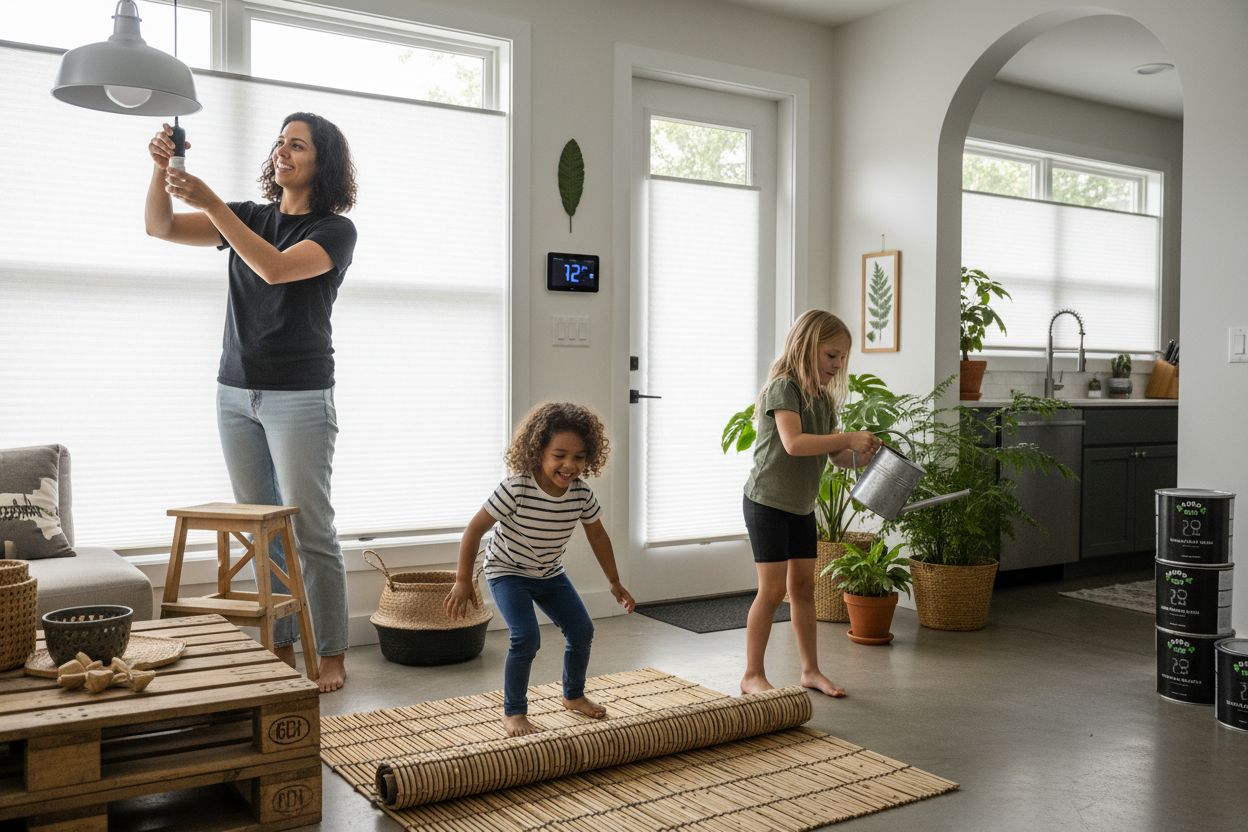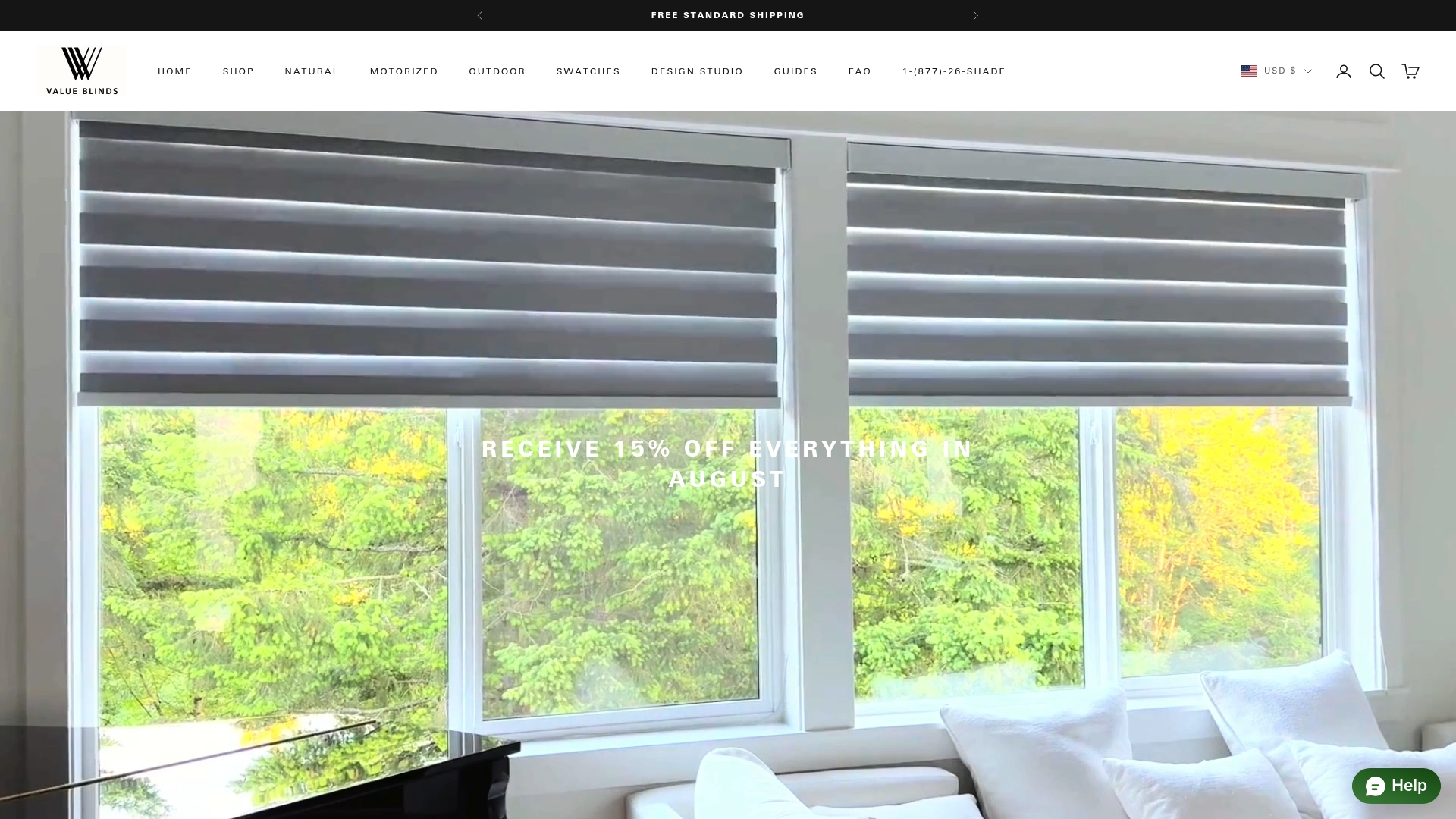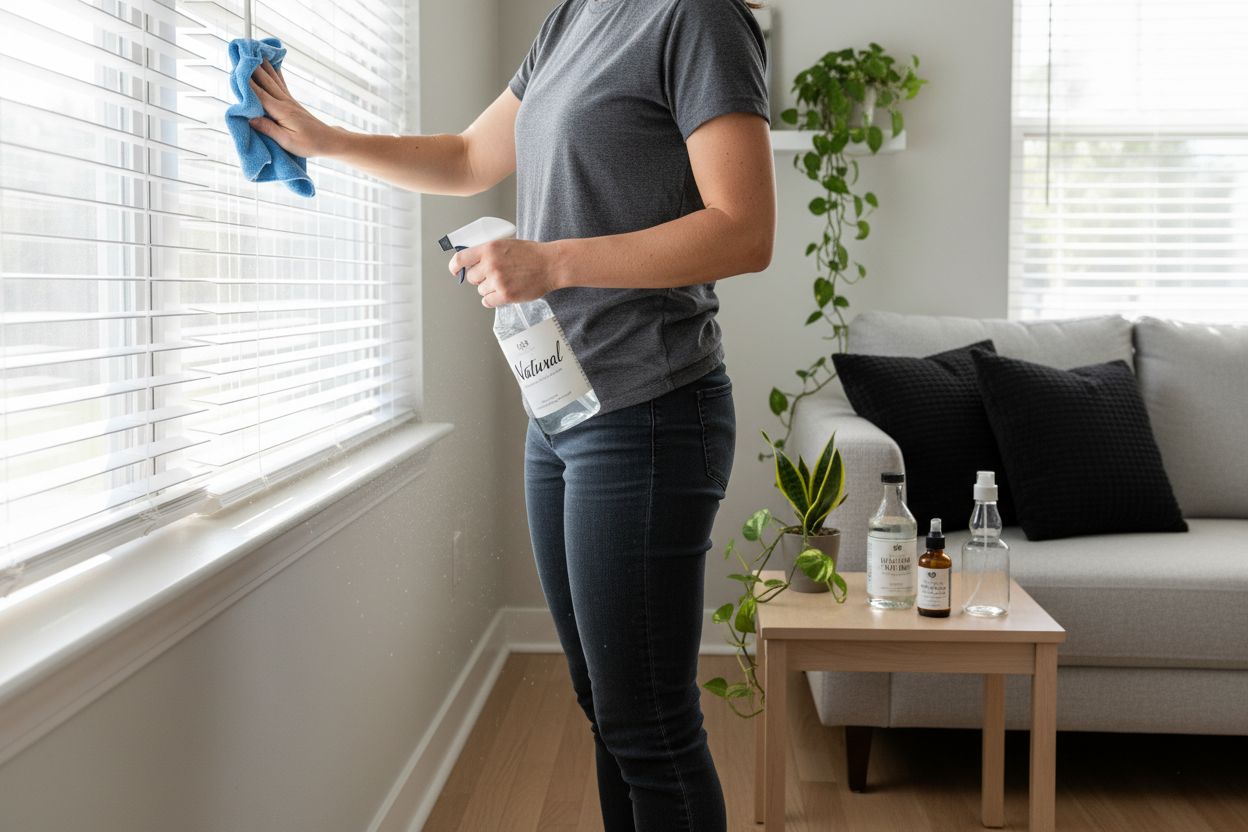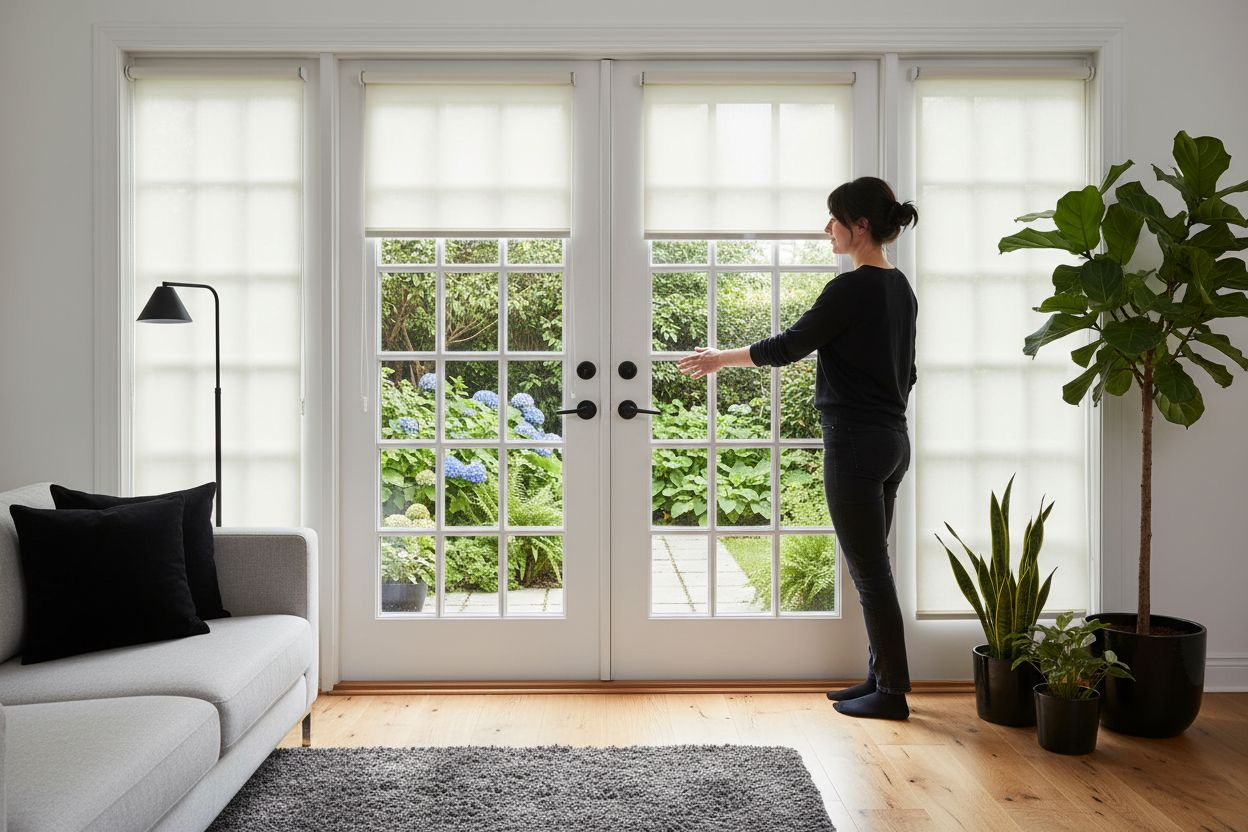
7 Smart Sustainable Home Improvements for Modern Living
Did you know that homes can lose up to 40 percent of their heating energy through windows alone? Many people overlook simple upgrades that deliver real savings and comfort. Whether you want to lower bills, breathe easier, or help the planet, smart changes inside your home make a big difference. Small steps with window treatments, lighting, and material choices help create a healthier space without sacrificing style or convenience.
Quick Summary
| Takeaway | Explanation |
|---|---|
| 1. Select energy-efficient window treatments | Choose coverings like cellular shades to improve insulation and reduce energy costs significantly. |
| 2. Upgrade to LED lighting for savings | Switch to LED bulbs to cut energy consumption by up to 50% and lower utility bills. |
| 3. Install water-saving fixtures | Use WaterSense labeled products to reduce water usage by up to 20% without sacrificing quality. |
| 4. Opt for eco-friendly flooring materials | Consider bamboo or cork for sustainable flooring that offers durability and aesthetic appeal. |
| 5. Choose low-VOC paints for healthier air | Use low or zero VOC paints to improve indoor air quality and reduce harmful emissions in your home. |
Table of Contents
- Choose Energy-Efficient Window Treatments For Insulation
- Install LED Lighting To Reduce Power Consumption
- Opt For Water-Saving Fixtures In Kitchens And Bathrooms
- Upgrade To Eco-Friendly Flooring For Durability
- Select Low-VOC Paints For Healthier Indoor Air
- Incorporate Recycled Or Bamboo Materials In Decor
- Utilize Smart Home Tech To Monitor Energy Usage
1. Choose Energy-Efficient Window Treatments for Insulation
Window treatments are more than just decorative elements they are powerful tools for improving your home’s energy efficiency and comfort. Selecting the right window coverings can dramatically reduce your energy consumption and create a more comfortable living environment.
According to the U.S. Department of Energy, energy-efficient window treatments can reduce heat loss by up to 40% during heating seasons and cut unwanted solar gain by 60% during cooling seasons. This means substantial savings on your utility bills and a significant reduction in your home’s carbon footprint.
Cellular shades (also known as honeycomb shades) are particularly effective for insulation. Their unique design creates air pockets that trap heat in winter and block solar radiation in summer. By installing these shades, you create a protective barrier that helps maintain consistent indoor temperatures.
When choosing energy-efficient window treatments, consider these key factors:
- Insulation value: Look for treatments with multiple layers or specialized materials
- Light control: Select options that allow you to adjust sunlight and heat penetration
- Material durability: Choose treatments that can withstand temperature fluctuations
Pro tip: Read our guide on energy-efficient window treatments to explore more detailed strategies for maximizing your home’s thermal performance. By investing in smart window coverings, you are not just enhancing your home’s aesthetics but also creating a more sustainable and comfortable living space.
2. Install LED Lighting to Reduce Power Consumption
Lighting is a silent energy consumer that can dramatically impact your home’s overall power usage. LED technology has revolutionized how we think about residential illumination, offering an intelligent solution for homeowners seeking both energy efficiency and cost savings.
Research from a comprehensive study in academic institutions demonstrates that LED lighting can deliver up to 50% energy savings compared to traditional fluorescent alternatives. This significant reduction translates into lower electricity bills and a substantial decrease in your home’s carbon footprint.
LED lights are not just about energy efficiency they represent a comprehensive upgrade for your living space. These advanced lighting solutions offer remarkable benefits beyond power consumption:
- Extended lifespan: LEDs last significantly longer than traditional bulbs
- Reduced maintenance costs: Fewer replacements mean less waste and expense
- Superior light quality: Brighter, more consistent illumination with less heat generation
Implementing LED lighting is straightforward and can be done gradually. Start by replacing bulbs in high-traffic areas like kitchens, living rooms, and home offices. Look for bulbs with ENERGY STAR certification to ensure maximum efficiency. Pro tip: Consider smart LED bulbs that allow you to control brightness and color temperature through your smartphone, providing both energy management and ambiance control.
Learn more about smart home lighting strategies to maximize your energy savings and create a more sustainable living environment. By making this simple switch, you are not just saving money but also contributing to a greener future.
3. Opt for Water-Saving Fixtures in Kitchens and Bathrooms
Water conservation starts at home, and your kitchen and bathroom fixtures play a critical role in reducing unnecessary water consumption. Modern water-saving technologies allow homeowners to significantly decrease their water usage without sacrificing performance or comfort.
Toilets, faucets, and showerheads represent major opportunities for water efficiency. By selecting WaterSense labeled fixtures, you can reduce water usage by up to 20% compared to standard models. These innovative fixtures use advanced design techniques to maintain strong water pressure while using substantially less water.
When considering water-saving upgrades, focus on these key areas:
- Low flow toilets: Consume 1.28 gallons per flush or less
- Sensor faucets: Automatically control water flow and prevent wastage
- Efficient showerheads: Limit water flow to 2.0 gallons per minute
Smart installation matters. Look for fixtures with aerators that mix air with water, creating a powerful stream while using minimal water. Some modern showerheads even include pause buttons that allow you to stop water flow while lathering, further reducing consumption.
Beyond fixture selection, consider your daily habits. Fixing leaky faucets, taking shorter showers, and turning off the tap while brushing teeth can compound your water savings. Pro tip: Many water-saving fixtures come with dual flush options, allowing you to choose between a full or reduced flush depending on need.
Check out our guide on sustainable home upgrades to explore more ways you can create an eco-friendly living space. By making these simple changes, you are not just saving water but also reducing your utility bills and supporting environmental conservation.
4. Upgrade to Eco-Friendly Flooring for Durability
Your home’s flooring is more than just a surface to walk on it is a critical element of sustainable interior design. Eco-friendly flooring options not only reduce environmental impact but also provide exceptional durability and aesthetic appeal for modern homeowners.
Today’s sustainable flooring materials go far beyond traditional hardwood. Innovative options like bamboo, cork, reclaimed wood, and recycled materials offer incredible performance while supporting environmental conservation. These materials are sourced responsibly, have lower carbon footprints, and can withstand years of heavy use.
When selecting eco-friendly flooring, consider these key characteristics:
- Renewable materials: Bamboo and cork regenerate quickly
- Recycled content: Flooring made from reclaimed wood or plastic
- Low chemical emissions: Materials with minimal volatile organic compounds
Bamboo flooring stands out as an exceptional choice. Growing up to three feet per day, bamboo reaches maturity in just five years compared to decades for traditional hardwood trees. It offers remarkable hardness comparable to oak while providing a sleek, contemporary look for your living spaces.
Cork flooring presents another sustainable alternative. Harvested from bark without destroying the tree, cork provides natural insulation, sound absorption, and a unique textural appearance. Its inherent resilience makes it perfect for high traffic areas while supporting forest conservation efforts.
Pro tip: Look for certifications like FSC (Forest Stewardship Council) or Greenguard when selecting eco-friendly flooring to ensure genuine sustainability. Learn more about environmentally responsible home design to create a living space that looks great and supports planetary health.
5. Select Low-VOC Paints for Healthier Indoor Air
The paint on your walls does more than just add color it significantly impacts the air quality and overall health of your living environment. Traditional paints release volatile organic compounds (VOCs) that can create invisible yet harmful indoor air pollution, potentially causing respiratory issues and long term health concerns.
Low VOC and zero VOC paints represent a revolutionary approach to home decoration. These advanced paint formulations dramatically reduce toxic chemical emissions, creating safer and cleaner indoor spaces. Modern eco-friendly paints deliver the same vibrant colors and durability as traditional options while prioritizing your family’s health and environmental responsibility.
When selecting low VOC paints, focus on these critical aspects:
- Zero VOC certification: Look for paints with official environmental ratings
- Natural ingredient bases: Seek paints made from plant derived materials
- Minimal odor: Choose options that do not produce strong chemical smells
Beyond health benefits, low VOC paints offer excellent performance characteristics. They provide superior coverage, resist mildew, and maintain color integrity longer than traditional paint formulations. Many brands now offer extensive color ranges that meet both aesthetic and environmental standards.
Pro tip: Ventilate your space during and after painting, even with low VOC products. Consider applying paint during dry seasons when you can open windows to support air circulation. Some brands now offer additional air purifying properties that actively remove indoor pollutants.
Explore sustainable home improvement strategies to create a healthier living environment. By making mindful paint selections, you are investing in your home’s beauty and your family’s well being.
6. Incorporate Recycled or Bamboo Materials in Decor
Sustainable interior design goes beyond aesthetics it is about making conscious choices that support environmental preservation. Recycled and bamboo materials offer an innovative approach to decorating your home while minimizing ecological impact.
Bamboo stands out as an extraordinary material in sustainable design. According to architectural research, bamboo grows incredibly fast and provides remarkable strength comparable to traditional building materials. Its unique properties make it an ideal choice for everything from furniture to decorative elements.
When incorporating sustainable materials, consider these versatile options:
- Bamboo furniture: Chairs, tables, and shelving units
- Recycled glass decor: Vases, light fixtures, and accent pieces
- Reclaimed wood elements: Wall art, picture frames, and decorative panels
Researchers have discovered that bamboo composites combined with bio-based epoxy demonstrate exceptional characteristics. These materials offer high strength, thermal stability, and low moisture absorption, making them perfect for long lasting home decor. The material is not just environmentally friendly but also incredibly durable and aesthetically pleasing.
Bamboo’s ecological credentials are impressive. It grows up to three feet per day and can be harvested without destroying the plant, making it one of the most renewable resources available. By choosing bamboo products, you are supporting sustainable forestry and reducing your carbon footprint.
Pro tip: Mix recycled and bamboo materials to create unique, textured spaces that tell a story of environmental responsibility. Discover more about sustainable home design and transform your living space into an eco-conscious sanctuary.
7. Utilize Smart Home Tech to Monitor Energy Usage
Smart home technology transforms how we understand and manage energy consumption, turning complex data into actionable insights for homeowners. Modern technological solutions provide real time tracking and intelligent management of your home’s electricity usage, empowering you to make informed decisions about energy efficiency.
Smart home energy monitoring systems work by connecting to your electrical panel and tracking electricity consumption across different appliances and circuits. These intelligent systems provide detailed breakdowns of energy usage, helping you identify unexpected power drains and potential areas for optimization.
Key features of smart energy monitoring technology include:
- Real time electricity tracking: Monitor consumption instantly
- Detailed appliance level insights: Understand which devices consume most power
- Automated energy saving recommendations: Receive personalized efficiency suggestions
Wireless smart plugs and advanced energy monitors allow you to control and track individual device consumption. Some advanced systems can automatically turn off devices during peak electricity pricing hours, helping you reduce utility bills and environmental impact.
Many modern smart home systems integrate with smartphone apps, providing comprehensive dashboards that display energy consumption patterns. These tools can help you set energy reduction goals, track progress, and receive notifications about unusual power usage.
Pro tip: Combine smart energy monitors with programmable thermostats and home automation systems to create a comprehensive energy management strategy. By leveraging technology, you can transform your home into an intelligent, efficient living space that saves money and supports environmental sustainability.
This table offers a comprehensive summary of strategies for enhancing home sustainability and energy efficiency, as detailed in the article.
| Topic | Key Points & Actions | Benefits/Outcomes |
|---|---|---|
| Energy-Efficient Window Treatments | Choose cellular shades for insulation; consider insulation value, light control, and material durability. | Reduce heat loss by 40%, cut solar gain by 60%, and lower utility bills. |
| LED Lighting Installation | Replace traditional bulbs with LED lights; select ENERGY STAR certified bulbs for maximum efficiency. | Save up to 50% on energy costs, lower maintenance, enhance lighting quality. |
| Water-Saving Fixtures | Install WaterSense labeled toilets, showerheads, and faucets; use aerators for efficient water use. | Decrease water usage by 20%, reduce utility bills, conserve water. |
| Eco-Friendly Flooring | Opt for bamboo, cork, or recycled materials; look for FSC or Greenguard certifications. | Enhanced durability, lower carbon footprint, support sustainable sourcing. |
| Low-VOC Paint Selection | Use low or zero VOC paints; choose options with natural ingredients and minimal odor. | Improve indoor air quality, reduce health risks, maintain vibrant colors. |
| Sustainable Decor Materials | Incorporate bamboo and recycled materials in furniture and decoration. | Minimize ecological impact, support renewable resources, add aesthetic value. |
| Smart Home Tech for Energy | Use smart energy monitors, smart plugs; integrate with home automation systems for optimized control. | Monitor and reduce energy usage, save on utility bills, enhance sustainability. |
Transform Your Home With Smarter, Sustainable Window Solutions
Feeling the pressure to create a cozy, energy-saving home while keeping your style fresh and modern? The article highlights common struggles like rising energy bills, comfort issues, and the overwhelming search for sustainable living upgrades. Often, homeowners want easy improvements that make a real difference, such as boosting insulation with energy-efficient shades, choosing healthier materials, and picking solutions that fit today’s lifestyles.
Explore trending features for blinds and shades that meet your need for comfort, savings, and a beautiful home environment.

Now is the perfect time to make these sustainable changes a reality. Browse new arrivals for the latest in eco-friendly, stylish custom window coverings. For expert guidance and easy online selection, visit Value Blinds Direct today and take that step toward a smarter, healthier, and more comfortable home.
Frequently Asked Questions
What are the best energy-efficient window treatments to improve insulation?
Choose cellular shades, as their design features air pockets that help trap heat in winter and block solar gains in summer. To enhance thermal performance further, look for treatments with multiple layers or specialty materials that can reduce heat loss by up to 40%.
How can I reduce my utility bills by upgrading to LED lighting?
Switching to LED lighting can save you up to 50% on your electricity costs compared to fluorescent bulbs. Start by replacing the bulbs in your most frequently used spaces, such as kitchens and living areas, and opt for ENERGY STAR certified products to maximize your savings.
What are effective water-saving fixtures I can install in my home?
Install low flow toilets, sensor faucets, and efficient showerheads to significantly cut your water usage by 20% or more. Opt for fixtures labeled by WaterSense or those that feature aerators for optimal performance while conserving water.
How do I choose eco-friendly flooring materials for my home?
Select sustainable flooring options like bamboo or cork, which are renewable and possess lower carbon footprints compared to traditional materials. Look for products that use minimal volatile organic compounds (VOCs) to create a healthier indoor environment.
What benefits do low-VOC paints provide for indoor air quality?
Low-VOC and zero VOC paints improve indoor air quality by reducing harmful chemical emissions that can affect respiratory health. When painting, ensure to choose products with zero VOC certification for a safer, more environmentally responsible option in your home.
How can smart home technology help me monitor my energy usage?
Utilize smart home energy monitoring systems to track your electricity consumption in real time. By observing detailed usage patterns, you can uncover areas to optimize and reduce your energy bills, potentially saving up to 30% on monthly utility costs.







